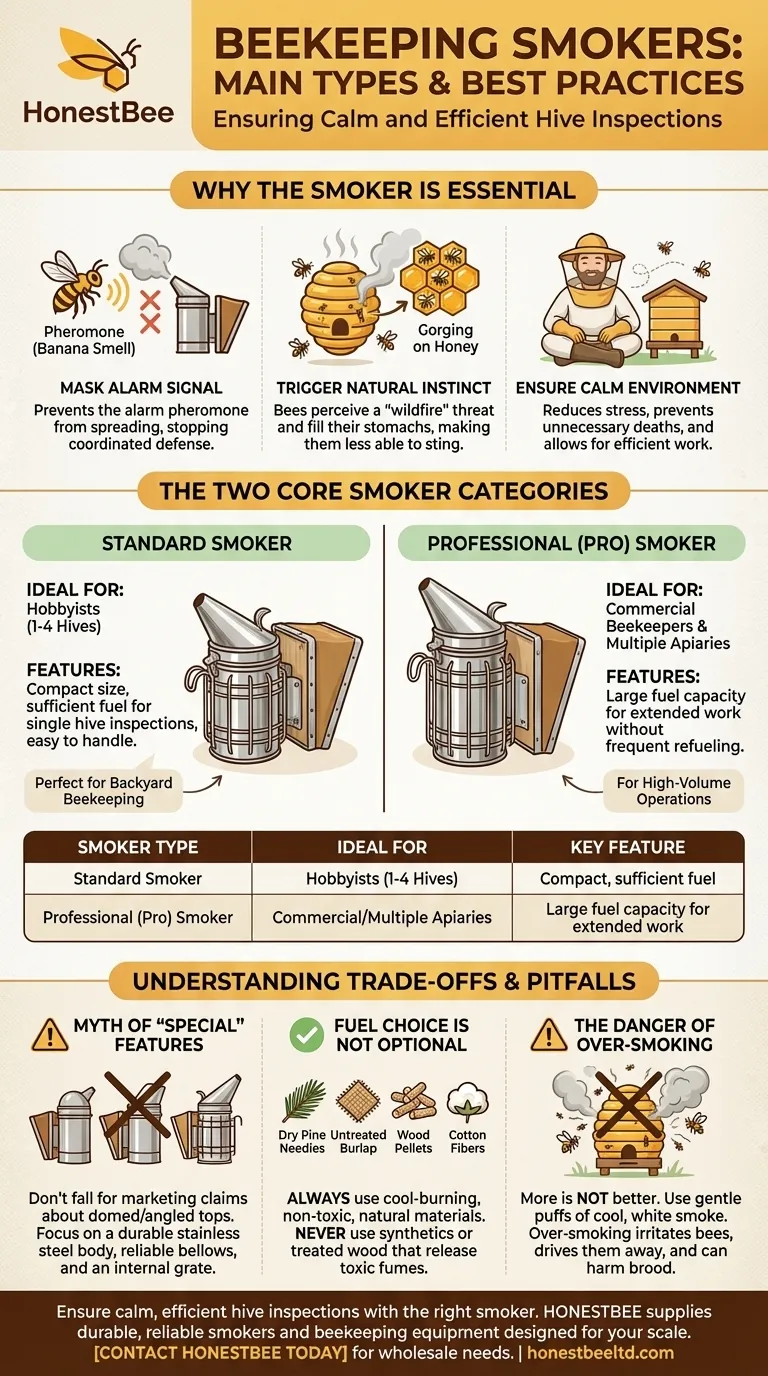When selecting a bee smoker, you will find that the options are straightforward and primarily defined by size, not complex features. The two main types are the standard stainless steel smoker, ideal for hobbyists, and the larger "pro" smoker, designed for beekeepers who manage more hives or require longer-lasting smoke. The fundamental difference between them is their fuel capacity and, consequently, the duration they can produce smoke before needing to be refilled.
Choosing a bee smoker is less about specific features and more about scale. Your decision boils down to matching the smoker's size and fuel capacity to the number of hives you manage and the length of time you need to work with them.

Why the Smoker is an Essential Tool
Before comparing models, it's critical to understand why a smoker is non-negotiable for safe and effective beekeeping. Its function is rooted in bee biology.
Masking the Alarm Signal
When a hive feels threatened, guard bees release an alarm pheromone (isopentyl acetate), which smells like bananas. This chemical signal alerts other bees to the danger and triggers a coordinated defensive response, leading to stings. A smoker masks this pheromone, effectively preventing the alarm from spreading throughout the colony.
Triggering a Natural Instinct
The presence of smoke also triggers an ancient survival instinct in bees. They perceive it as a potential wildfire, prompting them to prepare to abandon the hive. Their first action is to gorge themselves on honey to have enough energy for the journey. A bee with a full stomach is physically less able to flex its abdomen to sting and is generally more docile.
Ensuring Calm for Bee and Beekeeper
By calming the colony, you create a safer environment for yourself and reduce stress on the bees. A calm inspection prevents unnecessary bee deaths and allows you to work more efficiently, whether you're checking for disease, assessing honey stores, or harvesting.
The Two Core Smoker Categories
While you may see variations in design, smokers fall into two functional groups based on their capacity.
The Standard Smoker
This is the most common model, typically made of stainless steel with an attached bellows. Its canister size is perfect for backyard beekeepers who manage a small number of hives (typically 1-4). It holds enough fuel for a standard hive inspection without being overly cumbersome.
The Professional (Pro) Smoker
The "pro" smoker is simply a larger version of the standard model. It features a taller, wider canister that can hold significantly more fuel. This allows for longer burn times, which is essential for commercial beekeepers or those who need to work through many hives in a single session without stopping to refuel.
Understanding the Trade-offs and Pitfalls
Your choice of smoker is important, but how you use it is even more critical. Avoiding common mistakes is key to success.
The Myth of "Special" Features
Some smokers are marketed with domed or angled tops. While there may be minor claims about smoke direction, these differences are primarily aesthetic. The core components that matter are a durable stainless steel body, a reliable bellows, and an internal grate to keep fuel elevated for proper airflow.
Fuel Choice is Not Optional
The material you burn is just as important as the smoker itself. Always use cool-burning, non-toxic, natural materials. Excellent choices include dry pine needles, untreated burlap, wood pellets, or cotton fibers. Never use synthetic materials, treated wood, or anything that could release toxic fumes, as this can harm or kill your bees.
The Danger of Over-smoking
More is not better. The goal is to use gentle puffs of cool, white smoke, not hot, heavy clouds. Over-smoking can irritate the bees, drive them from the frames you need to inspect, and in extreme cases, harm the brood. Use just enough smoke to keep the colony calm.
Making the Right Choice for Your Apiary
Your decision should be based on the practical realities of your beekeeping goals.
- If you are a hobbyist with 1-4 hives: A standard stainless steel smoker is sufficient, cost-effective, and easy to handle for typical inspections.
- If you manage multiple apiaries or work hives for extended periods: Invest in a larger "pro" smoker to avoid the inefficiency of frequent refueling.
- If your primary focus is bee health: Prioritize learning proper smoking technique and sourcing clean, natural fuel, as this will have a greater impact than the specific model you choose.
Ultimately, the best smoker is one that you can use comfortably and consistently to ensure calm, productive interactions with your bees.
Summary Table:
| Smoker Type | Ideal For | Key Feature |
|---|---|---|
| Standard Smoker | Hobbyists (1-4 hives) | Compact, sufficient fuel for single inspections |
| Professional (Pro) Smoker | Commercial beekeepers, multiple apiaries | Large fuel capacity for extended work without refueling |
Ensure calm, efficient hive inspections with the right smoker. Whether you're a hobbyist or manage a commercial apiary, HONESTBEE supplies durable, reliable smokers and beekeeping equipment designed for your scale. Our wholesale-focused operations provide the tools you need for successful hive management. Contact HONESTBEE today to discuss your equipment needs and keep your bees healthy and productive.
Visual Guide

Related Products
- European Stainless Steel Bee Smoker for Honey Bee Hive
- Economy Galvanized Beekeeping Honey Bee Smoker for Wholesale
- Professional Bee Smoker with Elongated Spout and Durable Bellows for Beekeeping
- Stainless Steel Honey Bee Smoker Hive and Honeycomb Smoker for Beekeeping
- Premium Traditional Copper Bee Smoker with Bellows
People Also Ask
- What are the steps to operate a bee smoker? Master the Art of Gentle Beehive Management
- What are the features of a recommended bee smoker? A Guide to Safety, Durability & Performance
- What are the benefits of cleaning a bee smoker? Ensure Hive Safety and Bee Health
- What are the advantages of a high-quality bee smoker? Achieve Calm, Confident Hive Management
- How does a smoker help during hive inspections? The Key to Calm, Safe Beekeeping



















